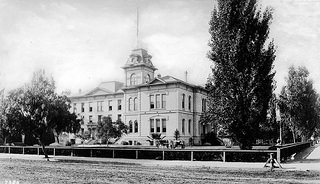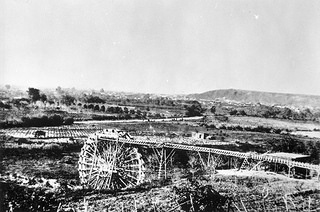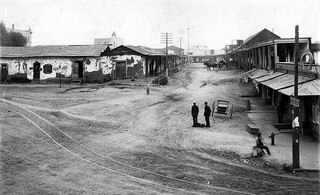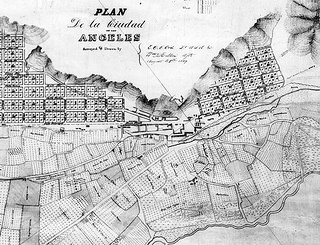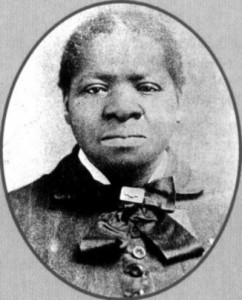Sonoratown, an early neighborhood
The neighborhood of “Sonoratown” acquired its name during the years of California's gold rush, when a wave of miners and other migrants from the Mexican province of Sonora settled there.
Drawn originally to Northern California's Gold Country, the Sonoran 49ers introduced several innovations, including the panning method, and quickly established themselves as some of the state's most successful prospectors. Beginning in 1848, when a ban on immigration from northern Mexico was lifted, thousands of Sonorans passed through Los Angeles every year on their way to the Gold ...
St. Vincent’s College for Boys
In 1865, the Vincentian Fathers were commissioned to found St. Vincent's College for boys in Los Angeles, and appointed John Asmuth, C.M. as its first President Rector. The college was originally located in the Lugo Adobe House at the southeast corner of Alameda and Los Angeles streets. The building was one of the few two-story complexes in the city at that time and had been donated by Vicente Lugo.
Although the building no longer stands, its original site was across Alameda Street from the current Union Station on the Plaza near the southeast end of the city's historic ...
Waterwheel and the Zanja Madre
In 1857 William Dryden and his newly incorporated water company, Los Angeles Water Works Co., erected a forty foot water wheel to lift water from the Los Angeles River to the city's main water ditch, the Zanja Madre. An image of this water wheel can be seen on the left, which was captured in 1863. Dryden constructed a large brick and wood storage tank in 1858 in La Placita, the city's plaza which was located about one mile north of Azusa Street. It would remain there for about 10 years and then be replaced by a fountain. Afterward, water would continue to be stored in ...
Calle de los Negros
Los Angeles Street was first named in 1854. Before the first official survey of the area in 1849, most of this thoroughfare was called Calle Principal (Main Street). Other sections were known as Calle de la Zanja (Ditch Street), Calle de Los Vinas (Vineyard Street) and--much to the south--Calle de los Huertos (Orchard Street), which is now San Pedro Street. These formed the principal highway running south to the Embarcadero of San Pedro.
At its northern end, near the Plaza, a 500-foot stretch was known as Calle de Los Negros, which had a racially diverse population. ...
Early View of Los Angeles
This is an old photograph of an accurate model of Los Angeles as it appeared in 1850 when Los Angeles became an incorporated city. Looking northeast, the layout of the new city can clearly be seen with the Los Angeles Plaza located in the lower left-center. The large white structure to the left of the Plaza is the Old Plaza Church. The two streets running from bottom of photo to the Plaza are Main Street on the left and Los Angeles Street on the right. Alameda Street runs from the lower right corner diagonally toward the lower center of photo. The L.A. River can be seen ...
Los Angeles Becomes a City
On April 4, 1850, Los Angeles was incorporated as a municipality, five months before California achieved statehood. In 1850, the population of Los Angeles was 1,610 and the U.S. Census recorded 15 blacks, 8 Jews and 2 Chinese residing in Los Angeles County.
Wolfskill Ranch established
William Wolfskill, a native of Kentucky, came to California in 1831 and settled in Los Angeles in 1836, where he soon met and married Magdalena Lugo, daughter of Jose Ygnacio Lugo. In March 1838, Wolfskill purchased a 100-acre lot bounded by 3rd to 9th streets and San Pedro to Alameda streets, which he named Wolfskill Ranch, and built a large adobe (known as "Wolfskill Adobe") located at 239 Alameda, between 3rd and 4th streets. This land is located a few blocks away from Azusa Street on the other side of the L.A. River.
In 1839, Wolfskill became a major grape producer ...
John Edward Hollenbeck
John Edward Hollenbeck was an American businessman and investor who was significantly involved in the 19th century development of downtown Los Angeles.
Arriving in Los Angeles a wealthy man from his investments in Nicaragua in 1876, Hollenbeck purchased land on the east side of the Los Angeles River, and built a large residence with broad verandas and a tower on extensive grounds on Boyle Avenue and may have owned the land that became Azusa Street. He made twenty-seven acquisitions of property by 1880. In 1884 he purchased and developed an urban business district, known ...
Biddy Mason is Born
Bridget ("Biddy") Mason was born a slave on a Mississippi plantation. When her owner, Robert M. Smith, became a Mormon convert in 1847, Mason and her three daughters joined his family on a 2,000-mile trek to the Utah Territory during which Mason was responsible for herding the cattle, preparing the meals and serving as midwife. Four years later, Smith moved his household to San Bernardino County, Calif., where Brigham Young was starting a Mormon community. California being a free state, Mason and her daughters petitioned the court for their freedom, which was granted in ...
Mission San Gabriel Arcángel
Founded by Fathers Pedro Benito Cambón and Angel Fernandez Somera y Balbuena in 1771, the mission was originally established along the slopes of the Montebello hills at the native site of Shevaanga, overlooking the San Gabriel Valley. In 1775 the mission was relocated to the native site of Iisanchanga about three miles to the northwest, where it currently stands being about nine miles east of Azusa Street.
Within fifteen years of its founding San Gabriel had 1,000 neophytes, or newly converted believers. The highest population recorded was 1,701, in 1817. Well over ...



